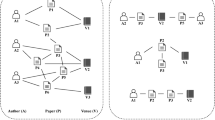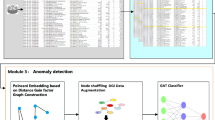Abstract
Discovering the hierarchical structures of different classes of object behaviors can satisfy the requirements of various degrees of abstraction in association analysis, behavior modeling, data preprocessing, pattern recognition and decision making, etc. In this paper, we call this process as associative categorization, which is different from classical clustering, associative classification and associative clustering. Focusing on representing the associations of behaviors and the corresponding uncertainties, we propose the method for constructing a Markov network (MN) from the results of frequent pattern mining, called item-associative Markov network (IAMN), where nodes and edges represent the frequent patterns and their associations respectively. We further discuss the properties of a probabilistic graphical-model to guarantee the IAMN’s correctness theoretically. Then, we adopt the concept of chordal to reflect the closeness of nodes in the IAMN. Adopting the algorithm for constructing join trees from an MN, we give the algorithm for IAMN-based associative categorization by hierarchical bottom-up aggregations of nodes. Experimental results show-the effectiveness, efficiency and correctness of our methods.
Similar content being viewed by others
Explore related subjects
Discover the latest articles and news from researchers in related subjects, suggested using machine learning.References
Liu W, Yue K, Wu T, Wei M. An approach for multi-objective catego rization based on the game theory and Markov process. Applied Soft Computing, 2011, 11(6): 4087–4096
Agrawal R, Imielinski T, Swami A. Mining association rules between sets of items in large databases. In: Proceedings of the 1993 ACM SIGMOD International Conference on Management of Data, 1993, 207–216
Han J, Kamber M. Data Mining: Concepts and Techniques. 1st ed. Morgan Kaufmann, 2000
Han J, Cheng H, Xin D, Yan X. Frequent pattern mining: current status and future directions. Data Mining and Knowledge Discovery, 2007, 15(1): 55–85
Chaoji V, A I Hasan M, Salem S, Zaki M. An integrated, generic approach to pattern mining: data mining template library. Data Mining and Knowledge Discovery, 2008, 17(1): 457–495.
Sudhamathy G, Venkateswaran C. An efficient hierarchical frequent pattern analysis approach for web usage mining. International Journal of Computer Applications, 2012, 43(15): 1–7
Ji L, Tan K, Tung A. Compressed hierarchical mining of frequent closed patterns from dense data sets. IEEE Transactions on Knowledge and Data Engineering, 2007, 19(9): 1175–1187
Cui P, Liu Z, Sun L, Yang S. Hierarchical visual event pattern mining and its applications. Data Mining and Knowledge Discovery, 2011, 22(1): 467–492.
Nguyen V, Yamamoto A. Mining of closed frequent subtrees from frequently updated databases. Intelligent Data Analysis, 2012, 16(6): 953–967
Jain A. Data clustering: 50 years beyond k-means. Pattern Recognition Letters, 2010, 31(8): 651–666
Forestier G, Gancarski P, Wemmert C. Collaborative clustering with background knowledge. Data and Knowledge Engineering, 2010, 69(2): 211–228
Thabtah F. A review of associative classification mining. The Knowledge Engineering Review, 2007, 22(1): 37–65
Baralis E, Garza P. I-prune: item selection for associative classification. International Journal of Intelligent Systems, 2012, 27(1): 279–299
Wang X, Yue K, Niu W, Shi Z. An approach for adaptive associative classification. Expert Systems with Applications, 2011, 38(9): 11873–11883
Lucas J, Laurent A, Moreno M, Teisseire M. A fuzzy associative classification approach for recommender systems. International Journal of Uncertainty, Fuzziness and Knowledge-Based Systems, 2012, 20(4): 579–617
Sinkkonen J, Nikkilä J, Lahti L, Kaski S. Associative clustering. Lecture Notes in Computer Science, 2004, 3201: 396–406
Kaski S, Nikkila J, Sinkkonen J, Lahti L, Knuuttila J, Roos C. Associative clustering for exploring dependencies between functional genomics data sets. IEEE/ACM Transactions on Computational Biology and Bioinformatics, 2005, 2(1): 203–216
Pearl J. Probabilistic Reasoning in Intelligent Systems: Network of Plausible Inference. San Mateo: Morgan Kaufmann, 1988
Wong S, Butz C. Constructing the dependency structure of a multiagent probabilistic network. IEEE Transactions on Knowledge and Data Engineering, 2001, 13(1): 395–415.
George D, Hawkins J. A hierarchical Bayesian model of invariant pattern recognition in the visual cortex. In: Proceedings of the 2005 IEEE International Joint Conference on Neural Networks. 2005, 3: 1812–1817
Hu C, Wu X, Hu X, Yao H. Computing and pruning method for frequent pattern interestingness based on Bayesian networks. Journal of Software, 2011, 22(12): 2934–2950
Bowes J, Neufeld E, Greer J, Cooke J. A comparison of association rule discovery and Bayesian network causal inference algorithms to discover relationships in discrete data. Lecture Notes in Computer Science, 2000, 1822: 326–336
Jaroszewicz S, Scheffer T. Fast discovery of unexpected patterns in data, relative to a Bayesian network. In: Proceedings of the 11th ACM SIGKDD International Conference on Knowledge Discovery in Data Mining. 2005, 118–127
Malhas R, Aghbari Z. Interestingness filtering engine: mining Bayesian networks for interesting patterns. Expert Systems with Applications, 2009, 36(1): 5137–5145
Fauré C, Delprat S, Boulicaut J, Mille A. Iterative Bayesian network implementation by using annotated association rules. Lecture Notes in Computer Science, 2006, 4248: 326–333
Yu K, Wu X, Ding W, Wang H, Yao H. Causal associative classification. In: Proceedings of the 11th IEEE International Conference on Data Mining. 2011, 914–923
ScienceDirect. http://www.sciencedirect.icom/, 2012
Cheng J, Bell D. Liu W. Learning Bayesian network from data: an efficient approach based on information theory. In: Proceedings of the 1997 Conference on Information and Knowledge Management. 1997, 325–331
Author information
Authors and Affiliations
Corresponding author
Additional information
Weiyi Liu graduated from Huazhong University of Science and Technology, China in 1976. He has been a professor and PhD supervisor of Yunnan University, China. His current research interests mainly include artificial intelligence, data and knowledge engineering. He is an associate member of the IEEE Computer Society
Kun Yue graduated from Fudan University, China in 2004, and received an MS in Computer Science. He graduated from Yunnan University, China in 2009, and received a PhD in Computer Science. He has been a professor at Yunnan University. His research interests include data and knowledge engineering, Web data management, and uncertainty in artificial intelligence.
Hui Liu graduated from Yunnan University, China in 2013, and received an MS in computer science. His research interests include social network analysis and artificial intelligence.
Ping Zhang graduated from Yunnan University, China in 2013, and received an MS in computer science. Now he is currently a PhD candidate in Wuhan University, China. His research interests include massive data management and social network analysis.
Suiye Liu graduated from State University of New York at Binghamton, USA, and received a BS in Financial Economics and an MA in economics. Since then he has been working in financial service industry for 3 years and is currently pursuing his MBA degree. His research interests include financial data analysis and intelligent decision.
Qianyi Wang is an MS candidate of Faculty of Economics and Administration, University of Malaya, Malaysia. Her research interests include financial data analysis, macroeconomic, and political economy.
Rights and permissions
About this article
Cite this article
Liu, W., Yue, K., Liu, H. et al. Associative categorization of frequent patterns based on the probabilistic graphical model. Front. Comput. Sci. 8, 265–278 (2014). https://doi.org/10.1007/s11704-014-3173-z
Received:
Accepted:
Published:
Issue Date:
DOI: https://doi.org/10.1007/s11704-014-3173-z




